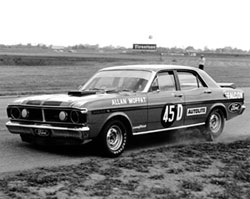
The Bathurst 1000 is a 1,000-kilometre (621.4 mi) touring car race held annually on the Mount Panorama Circuit in Bathurst, New South Wales, Australia. It is currently run as part of the Supercars Championship, the most recent incarnation of the Australian Touring Car Championship. In 1987 it was a round of the World Touring Car Championship.
Allan George MoffatOBE is a Canadian-Australian racing driver known for his four championships in the Australian Touring Car Championship, six wins in the Sandown 500 and his four wins in the Bathurst 500/1000. Moffat was inducted into the V8 Supercars Hall of Fame in 1999.
John GossOAM is an Australian retired motor racing driver who competed in his home country during the 1960s, 1970's and 1980's. He is the only driver to have won Australia's two most prestigious races, the Bathurst 1000, and the Australian Grand Prix (1976).
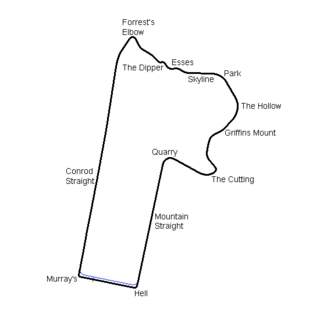
The 1975 Hardie-Ferodo 1000 was the 16th running of the Bathurst 1000 touring car race. It was an endurance race for touring cars complying with CAMS Group C regulations. The event was held at the Mount Panorama Circuit just outside Bathurst, New South Wales on 5 October 1975 over a distance of 1006.036 km. The race was Round 3 of the 1975 Australian Manufacturers' Championship.
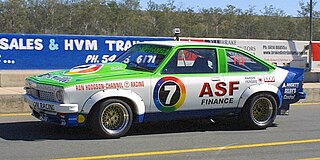
In relation to Australian motorsport, Group C refers to either of two sets of regulations devised by the Confederation of Australian Motor Sport (CAMS) for use in Australian Touring Car Racing from 1965 to 1984. These are not to be confused with the FIA's Group C sports car regulations, used from 1982 to 1992 for the World Endurance Championship / World Sports-Prototype Championship / World Sportscar Championship and the 24 Hours of Le Mans.

The 1982 James Hardie 1000 was the 23rd running of the Bathurst 1000 touring car race. It was held on 3 October 1982 at the Mount Panorama Circuit just outside Bathurst in New South Wales, Australia. The race, which was Round 3 of both the 1982 Australian Endurance Championship and the 1982 Australian Endurance Championship of Makes, was open to cars eligible to the locally developed CAMS Group C touring car regulations with two engine capacity based classes.
The Ford works team was the unofficial name for an Australian motor racing team which was supported by the Ford Motor Company of Australia. The team was formed in 1962 and was disbanded when Ford Australia withdrew from motor racing at the end of 1973. Drivers for the works team included Allan Moffat, Fred Gibson, Harry Firth, Bob Jane, Barry Seton, Bruce McPhee, John French, Ian Geoghegan and his brother Leo Geoghegan. Ford Australia also supported a factory rally team in Australia from 1977 to 1980.

The 1980 Hardie-Ferodo 1000 was the 21st running of the Bathurst 1000 touring car race. It was held on 5 October 1980 at the Mount Panorama Circuit just outside Bathurst in New South Wales, Australia. The race was open to cars eligible under the locally developed CAMS Group C Touring Car regulations with four engine capacity based classes.
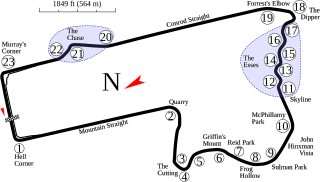
The 1991 James Hardie 12 Hour was an endurance race for production cars staged at the Mount Panorama Circuit, Bathurst, New South Wales, Australia, on 31 March 1991. It was the first "Bathurst 12 Hour". Of the 24 starters, 20 were classified as finishers.

The 1972 Hardie-Ferodo 500 was an endurance motor race open to Group E Series Production Touring Cars. The race was held on 1 October 1972 at the Mount Panorama Circuit just outside Bathurst in New South Wales, Australia. Cars competed in four classes defined by Capacity Price Units, where the engine capacity, expressed in litres, was multiplied by the purchase price in Australian dollars to arrive at a CP value for each vehicle. It was the 13th running of the Bathurst 500 race and the last to be held over the original distance of 500 miles. It was also the last to allow drivers to compete for the full distance without a relief driver. The race was the third round of the 1972 Australian Manufacturers' Championship.
The 1986 Australian Endurance Championship was a CAMS sanctioned motor racing title open to Touring Cars as specified in the National Competition Rules of CAMS. The title, which was the sixth Australian Endurance Championship, was contested concurrently with the 1986 Australian Manufacturers' Championship, which was the sixteenth in a sequence of manufacturers championships awarded by CAMS, and the seventh to be contested under the Australian Manufacturers' Championship name.

The 1968 Hardie-Ferodo 500 was a production car race held on 6 October 1968 at the Mount Panorama Circuit just outside Bathurst in New South Wales, Australia. It was the ninth running of the Bathurst 500.

The 1994 James Hardie 12 Hour was an endurance race for production cars held at the Mount Panorama Circuit, Bathurst, New South Wales, Australia on 3 April 1994. It was the fourth running of the "Bathurst 12 Hour". The race was open to cars of which at least ten examples had been sold and registered for use on Australian roads. Modifications in line with Group 3E Series Production Cars regulations, as published by the Confederation of Australian Motor Sport, were permitted.
The 1975 Australian Manufacturers' Championship was a CAMS sanctioned national motor racing title for vehicles manufacturers. The championship was contested over a five round series.
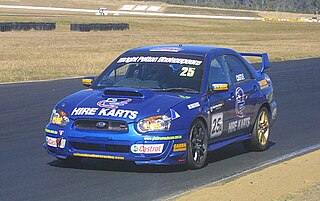
Group 3E Series Production Cars is an Australian motor racing formula for production based cars competing with limited modifications. Group 3E cars formerly contested the Australian Manufacturers' Championship and Australian Production Car Championship titles and compete in the annual Bathurst 12 Hour and Bathurst 6 Hour endurance races.
The 1985 Australian Manufacturers' Championship was a CAMS sanctioned motor racing title for car manufacturers. It was the 15th manufacturers title to be awarded by CAMS and the 6th to carry the Australian Manufacturers' Championship name. All championship rounds were open to cars complying with Australian Touring Car regulations, which were based on FIA Group A rules.
The 1973 Australian Manufacturers' Championship was a CAMS sanctioned motor racing title for automobile manufacturers. It was the third Australian Manufacturers' Championship and the first to be contested with Group C Touring Cars.
The 1972 Phillip Island 500K was an endurance motor race open to Group E Series Production Touring Cars. The event, which was Heat 4 of the 1972 Australian Manufacturers' Championship, was held on 21 October 1972 at the Phillip Island circuit in Victoria, Australia over a distance of 318 miles (512 km).

Group N Touring Cars is an Australian motor racing category for touring cars built before December 1972.
The Supercar scare was a national controversy that arose in Australia in 1972 in regard to the sale to the public of high performance "homologation special" versions of Australian-built passenger cars.
